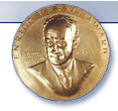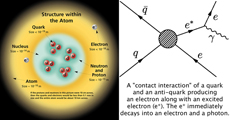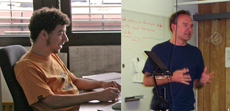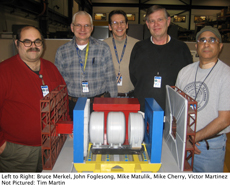|
Thursday, Jan. 10
9 a.m. - 6 p.m.
U.S. CMS "JTerm II workshop" -
One West
1 p.m.
Physics and Detector Seminar - WH-10NW, West Wing
Speaker: A. Para, Fermilab
Title: Possible SiD Implementations of Dual Readout Calorimetry
1 p.m.
Lecture - WH8XO
Speaker: Anatoli Butkevich, INR, Moscow
Title: Nuclear Effects in Neutrino Quasi-elastic Scattering
THERE WILL BE NO THEORETICAL PHYSICS SEMINAR THIS WEEK
3:30 p.m.
DIRECTOR'S COFFEE BREAK - 2nd Flr X-Over
THERE WILL BE NO ACCELERATOR PHYSICS AND TECHNOLOGY SEMINAR TODAY
Friday, Jan. 11
9 a.m. - 1:30 p.m.
U.S. CMS "JTerm II workshop" -
One West
3:30 p.m.
DIRECTOR'S COFFEE BREAK - 2nd Flr X-Over
4 p.m.
Joint Experimental-Theoretical Physics Seminar - One West
Speaker: M. Mattson, Wayne State University
Title: Evidence for 0 - 0 Mixing at CDF
Click here for NALCAL,
a weekly calendar with links to additional information.
|
Thursday, Jan. 10
- Minnesota wild rice w/chicken
- Tuna melt on nine grain
- BBQ ribs
- Chicken casserole
- Vegetarian salad wrap
- Assorted slice pizza
- Mandarin chicken
Wilson Hall Cafe menu |
|
Thursday, Jan. 10
Dinner
- Shrimp chowder
- Filet mignon w/pinot noir sauce
- Potato dauphinos
- Steamed green beans
- Marzipan cake
Wednesday, Jan. 16
Lunch
- Catfish fillet Veracruz
- Green rice
- Corn and red pepper
- Pecan chocolate tart
Chez Leon menu
Call x4598 to make your reservation. |
|
|
United we compute: FermiGrid continues to yield results

From February to May 2007, about 900 million D-Zero events were reprocessed with the help of FermiGrid resources. D-Zero is a high energy physics experiment that delves into the fundamental nature of matter.
Image courtesy of Peter Ginter
Before FermiGrid, the computing resources at high energy physics laboratory Fermilab, in Illinois, U.S., were individually packaged for the dedicated use of particular experiments.
By late 2004, all this began to change. The birth of FermiGrid, an initiative aiming to unite all of Fermilab's computing resources into a single grid infrastructure, changed the way that computing was done at the lab, improving efficiency and making better use of these resources along the way.
Faster physics from FermiGrid
FermiGrid was initially deployed for small Fermilab experiments and the Compact Muon Solenoid experiment; other large experiments-D-Zero and the Collider Detector at Fermilab-soon followed suit.
The ability to access FermiGrid resources has already paid off. As one example, researchers working on the D-Zero experiment recently decided to reprocess vast amounts of data in response to a detector upgrade. Thanks to FermiGrid, they were able to process about 900 million events between February and May of 2007, around 233 million of which used FermiGrid resources ostensibly belonging to CMS.
FermiGrid also plays a major role in the Collider Detector at Fermilab, which primarily uses grid resources to generate Monte Carlo data.
Read More
|
Sen. Durbin exploring financial help for Fermilab
From Crain's Chicago Business,
Jan. 9, 2007
U.S. Sen. Richard Durbin, D-Ill., is eyeing a partial stopgap remedy for Fermilab's budget crisis in a mid-year Iraq war emergency funding bill Congress is expected to consider this spring.
"It won't be a huge amount," says Mr. Durbin, the Senate's second-ranking Democrat and a senior member of the appropriations committee. "I don't want to suggest to anyone we will make them whole."
But any additional funding would help reduce temporary furloughs the lab is starting next month to save money.
"If there is a supplemental (appropriations bill), I'd like to stop (the furloughs) as quickly as possible," lab director Pier Oddone says.
Read more
See all related news stories here.
|
Nominations now accepted for Enrico Fermi Award
 |
| Nominations are now being accepted for the Enrico Fermi Award. |
The Enrico Fermi Award, a Presidential Award, is the oldest science and technology award given by the U.S. government, and one of the most prestigious. It is bestowed by the President of the United States to an individual or individuals of international stature in recognition of a lifetime of exceptional scientific, technical, engineering, and/or management achievements related to the development, use, control or production of energy.
Only living nominees will be considered. The Fermi Award is not limited to scientists whose work has been funded by the U.S. Department of Energy.
The deadline for nominations is April 1, 2008. Nominations are now accepted online.
|
When superconductivity became clear (to some)
From New York Times,
Jan. 8, 2007
Superconductivity, the flow of electricity without resistance, was once as confounding to physicists as it is to everyone else.
For almost 50 years, the heavyweights of physics brooded over the puzzle. Then, 50 years ago last month, the answer appeared in the journal Physical Review. It was titled, simply, "Theory of Superconductivity."
"It's certainly one of the greatest achievements in physics in the second half of the 20th century," said Malcolm R. Beasley, a professor of applied physics at Stanford.
Superconductivity was discovered in 1911 by a Dutch physicist, Heike Kamerlingh Onnes. He observed that when mercury was cooled to below minus-452 degrees Fahrenheit, about 7 degrees above absolute zero, electrical resistance suddenly disappeared, and mercury was a superconductor.
Read more
|
|
|
Searching for the excited

The left image depicts current knowledge about the structure of elementary particles. The right image demonstrates the process sought by DZero physicists to probe for electron substructure.
For at least a century the evolution of physics followed a predictable path: discovering particles believed to be "indivisible" and then carefully peering inside to see if they are truly fundamental. Like a Russian nesting doll, the nucleus contains protons and each proton contains quarks. It's a process that surely must eventually end, and many physicists believe that it has, with the discovery of the three generations of quarks and leptons (e.g., electrons or muons). But other scientists think there may be one more layer to this picture. Testing this exciting possibility depends on the particles themselves being excitable.
Since the 1970's, theories have suggested quarks and leptons might be composite structures representing bound states of smaller particles. Such theories could explain the spectrum of quarks and leptons we observe today as originating from a smaller set of more fundamental ingredients coupled via a novel strong interaction. If the electron, for example, were a composite particle, it should be capable of achieving an excited state by absorbing energy. These excited electrons could potentially decay back to their ground state by emitting a photon with a predictable energy, similar to the processes of fluorescence and phosphorescence. Depending on the size of the electron's sub-structure, the mass of the excited electron could be quite large and, perhaps, observable at the Tevatron.
Physicists at the DZero experiment have recently published the results of a search for an electron produced in association with an excited electron, which immediately decays to an electron and a photon. Using one inverse femtobarn of data, they see no evidence for excited electrons and limit the possible mass of an excited state to ~800 times the proton mass. This result is the most stringent limit to date. It joins current results from searches for compositeness in quarks and muons. With more data taken every day, DZero researchers are poised to take this exciting search one step further to probe smaller structures than ever before.

Volker Vorwerk (left) and Arnd Meyer (right) of RWTH Aachen made primary contributions to this analysis.

DZero's Electrical Support Group is responsible for the electrical systems required for all aspects of detector operation. Their dedicated efforts are essential for providing stable data collection conditions to enable analyses such as the one presented here.
Result of the Week Archive
|
|
Have a safe day!
Neutrino physics discussion Jan. 10
There will be two neutrino department physics discussions this week. On Wednesday, Jan. 9, from 10:30 a.m. - noon in WH8XO, Sergei Kulagin from INR, Moscow, will give a talk titled "Nuclear Effects in Electron and Neutrino Deep-Inelastic Scattering." On Thursday, Jan. 10, from 1-2 p.m. in WH8XO, Anatoli Butkevich from INR, Moscow, will give a talk titled "Nuclear Effects in Neutrino Quasi-elastic Scattering."
New location for International Services
The Visa Office and Assignment Services have joined the User's Office to form International Services. The office has moved to the first floor of Wilson Hall on the west side. The contact information is as follows: Amanda Petersen, x4203; Barb Book, x3111; Melissa Clayton Lang, x3933; and John Galvan, x3811. The mail stop is MS 103 and the fax is x3688.
LPC Jterm-II workshop Jan. 10-12
The LHC Physics Center at Fermilab will sponsor a workshop titled "Jterm - II" from Jan. 10-12. The workshop is named for the January term at LPC and is for graduate students and postdocs between semesters. The two-day workshop will include plenary talks and tutorials. For more information or to register, visit the workshop Web site. To register, click the evaluation button at the top of the Web site's agenda page.
Additional Activities |
|